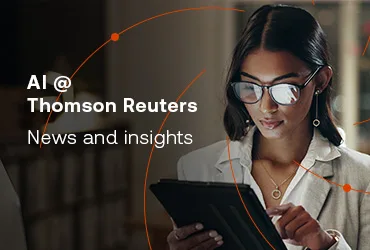Are you spending too much time on legal drafting? Consider how AI can streamline your drafting process and free up time for more engaging tasks.
No matter what role a lawyer plays for their clients, they often need to devote over half of their workweek to drafting documents. In the age of AI, however, this work imbalance could finally be corrected.
There are some hard truths about legal drafting. It takes up far more time than it should, and it’s far less efficient than it could be. Roughly 96% of legal professionals recently surveyed even said that they don’t believe their current drafting tools are adequate.
Enter AI-fueled solutions such as drafting in CoCounsel, which offers an end-to-end drafting process that gives lawyers a head start in their many client obligations. About 42% of surveyed legal professionals said they hope to get time to devote to “engaging, expertise-driven work.” By being liberated from the drudgery of half of their workday, a solution like drafting in CoCounsel can help them gain far more time to provide more valuable services to clients.
Jump to ↓
| Finding the right place to begin |
| The future of drafting, fueled by AI |
| Staying ahead with AI: Early adopters arrive first |
Finding the right place to begin
In Thomson Reuters’ Future of Professionals Report 2024, 50% of survey respondents said that they believe AI will provide an adequate place to begin an assignment but added they’ll “still need to do the majority of the work” themselves. By contrast, 37% said they think AI will put them at a strong or a “very strong” starting point, and that their job will greatly entail editing what their technology has produced.
What do legal professionals mean by a strong starting point? Take contract drafting, for example. Lawyers may find it time-consuming and frustrating to determine where best to begin a contract. Which template should be used? Which references should be employed? What new information needs to be incorporated into the document? What type of contractual language will be necessary?
There’s an art to choosing where to begin the drafting process; some lawyers say it takes up to two days to find the right starting point. Choosing the wrong place to start isn’t only a short-term stumble. It could kick off a drawn-out drafting process, with too many revisions needed and too much time spent in Track Changes.
Drafting in CoCounsel enables a lawyer to easily scan across data repositories to find the template that best suits the client’s needs. They can draw upon content from resources like Practical Law as well as retrieve all relevant files from their firm’s contract depository, allowing them to sharpen and add specificity to their contract’s language. They can quickly access and run comparisons on any sample documents that have relevance to their draft — well-regarded third-party contract clauses, for example.
The future of drafting, fueled by AI
For example, let’s say that a junior lawyer is tasked with drafting a third-party vendor agreement for a client.
In the past, this assignment would usually kick off with a lengthy process in which the lawyer sifts through databases to locate the best template, searches through emails and client folders to get a feel for the client’s needs and history, and spends a substantial amount of time looking up terminology and ensuring that all references are up to date.
Now imagine the same lawyer given the same assignment but with drafting capabilities in CoCounsel. Here, they quickly locate and assess any documents related to their current project with features including:
- Live Draft: Summarize, identify terms, and modify your open document instantly using quick prompts in natural language. Live Draft provides smart suggestions to meet your precise drafting standards and offers a list of suggested redlines you can choose to accept—cutting hours from your drafting process.
- Update Contract Terms: Save time creating a first draft by delegating tedious data entry and redaction to CoCounsel. Update a template or precedent agreement from your term sheet with tracked changes and annotations explaining each change, generating accurate documents instantly without manual input.
- CoCounsel Chat: Work faster without switching tools. Launch document analysis capabilities, use the Library, and interact with AI in natural language all within Microsoft Word.
Users can even search across internal document management systems, like SharePoint, OneDrive, iManage, HighQ, or NetDocuments, directly from Microsoft Word.
Finding relevant clauses becomes as simple as selecting an agreement and clause type and the system will display all relevant Practical Law clauses, SEC provisions, and templar language extracted from internal documents. As one user says, “using ‘draft a clause’ beats the heck of spending 30 minutes scrambling through Practical Law. And it definitely beats going through our document management system, trying to find the last time we used whatever language that was.”
When drafting the vendor contract, the lawyer easily drafts and modifies their clause language by drawing upon the CoCounsel AI Assistant, which is programmed to provide the most up-to-date and relevant terms (enhanced by domain and legal experts), with all information sources listed and easy to review.
The lawyer feels more confident in their drafting consistency thanks to deviation detection, comparing their draft to curated playbooks. The system will search for any missing clause language, any common transactional drafting errors, and any inconsistencies (such as in dates or contract terms) with previous or synchronous drafts. And all of this gets done in a fraction of the time that it would have taken before AI.
Staying ahead with AI: Early adopters arrive first
About 40% of professionals in the Future of Professionals Report said they believed that by 2029, most of their drafting will be done via AI-powered technologies, with lawyers shifting to mostly editing and reviewing documents.
At the same time, however, about 31% of respondents said they fear their department is moving too slowly when it comes to AI adoption, and that this delay could dull their department’s competitive edge. Rivals who embrace AI quicker and more thoroughly could gain substantial market share via lowered costs and greater efficiencies.
Indeed, a growing number of legal professionals believe that almost all of their work will be enhanced by AI over the next five years, and that every working lawyer will need to have a AI assistant — the sort of assistant who never takes time off, can handle complex tasks with natural language understanding, and offers an enhanced level of thoroughness.
Don’t settle for second place
By adopting next-generation applications like drafting in CoCounsel, legal departments can secure themselves in a strong position for the near future. Over the next few years, it’s likely that AI will move from being considered a desirable option in the legal industry to becoming a tool that no law firm can do without.
 |








